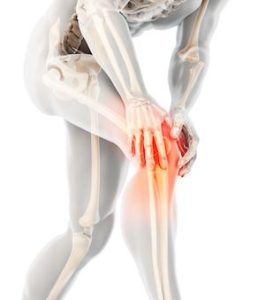Knee Injuries
Accident Lawyers for Victims of Knee Injuries in Naperville, St. Charles, and Throughout Illinois

Knee injuries are common with approximately 2.5 million patients presenting to emergency departments for sports related knee injuries alone. The knee is a large and complex joint made up of bone, cartilage, ligaments, and tendons. Due to the knee’s complex makeup, the knee is susceptible to a variety of injuries. Some of the most common knee injuries include fractures, dislocations, sprains, and strains. Knee injuries can be painful, and can limit your ability to work and complete daily activities. If you believe you have suffered a knee injury due to a car accident, fall down, sports related injury, or work-related injury, it is important to seek medical attention immediately to receive a proper evaluation and diagnosis.
How do knee injuries typically occur?
Knee injuries are typically caused by high energy trauma, such as motor vehicle collisions, slip and falls, and sports injuries. Knee injuries may also be caused as a result of a workplace injury. Abnormal twisting, pivoting, changing direction rapidly, or landing from a jump incorrectly can also cause a knee injury.
What is a knee injury settlement worth?
The settlement value of a knee injury case may be difficult to determine before reviewing medical evidence, such as medical records and bills, and having a clear understanding of the theory of liability. The value of knee injuries can vary from case to case, depending on the type of knee injury that occurred, the severity of injury, the likelihood of permanency, and the treatment provided. Generally, damages for past and future pain and suffering, loss of a normal life, past and future medical bills, and wage loss can be obtained in a knee injury settlement. However, a knee injury settlement can be diminished based on whether a plaintiff’s own negligence (or “comparative fault”) contributed to the injury, or when there are pre-existing medical conditions that may also have led to the injury or the need for treatment.
Some of Our Firm’s Recent Knee Injury Settlements
Premises liability (slip and fall), negligence. DuPage County, Illinois. Settlement for $100,000 was reached against a grocery store on behalf of a client who slipped and fell on a puddle of water that had repeatedly leaked from a freezer. The woman suffered a nerve injury that affected the use of her knee.
Motor vehicle accident, negligence. DuPage County, Illinois. Settlement for $97,500 was reached on behalf of a victim of a rear-end accident. As a result of the rear-end accident, the victim suffered knee pain and tingling. The motor vehicle accident claim was settled after a complaint was filed in DuPage County.
Pedestrian accident, negligence. DuPage County, Illinois. Settlement for $50,000 was reached on the behalf of a pedestrian that was struck by a motor vehicle while crossing the street. As a result of the motor vehicle collision, the victim suffered an MCL tear. The motor vehicle accident claim was settled with the at-fault party’s insurance carrier, Allstate Insurance Company.
Dog attack, negligence. Kane County, Illinois. Settlement for $46,195 was reached on behalf of a victim of a vicious dog attack by our Naperville dog bite lawyers. The dog attack claim was settled with the property owner’s insurance carrier, Farmers Insurance Company, after the dog suddenly attacked the victim and his dogs. The victim fell on his knees when attempting to separate the dogs and suffered a medial meniscus tear.
What are the symptoms of a knee injury?
Symptoms may vary depending on the severity and type of knee injury. However, signs and symptoms that can accompany a knee injury include:
- Swelling and stiffness
- Redness and warmth to the touch
- Inability to bear weight
- Inability to fully straighten or bend the knee
- Popping or crunching noises
- Weakness or instability
- Loss of range of motion
How is a knee injury diagnosed?
The initial evaluation of the knee will include a physical exam in which your physician will inspect your knee for swelling, pain, tenderness, warmth, and visible bruising. During the physical examination, your physician will also evaluate your ability to move your lower leg in different directions and will push on or pull the knee joint to evaluate the integrity of the structures within your knee. If further evaluation is necessary then your physician may suggest imaging tests such as:
X-Ray:
X-Rays are often used to diagnose fractured bones by using a very small amount of ionizing radiation to produce pictures of the body’s internal structures.
Computerized Tomography (CT) Scan:
A computerized tomography scan is a diagnostic imaging test that combines x-rays taken from many different angles to create cross sectional images of the inside of your body. The cross-sectional images generated can be reformatted into multiple planes and into three-dimensional images. Thus, a computerized tomography (CT) scan is useful in helping to diagnose subtle fractures and creating detailed images of internal organs, bones, soft tissue, and blood vessels.
Ultrasound:
Ultrasound technology generates sound waves that can be used to produce real time images of the body’s internal structures. Ultrasound technology is often used to provide images of soft tissue structures (useful for diagnosing injuries to the ligaments and tendons of the knee) that do not show up well on x-ray imaging.
Magnetic Resonance Imaging (MRI):
Magnetic resonance imaging (MRI) uses radio waves and a powerful magnetic field to produce detailed 3D images of the body’s internal structures. Magnetic resonance imaging (MRI) is particularly useful for evaluating and diagnosing injuries to soft tissues such as ligaments, tendons, cartilage, and muscle. Therefore, an MRI test would be useful in identifying injuries to the cruciate and collateral ligaments of the knee as well as injuries to the meniscus, quadriceps tendon, and patellar tendon.
Types of knee injuries
Fractures/Dislocations:
Three bones meet to form your knee joint: 1) the distal end of the femur (thigh bone), 2) the patella (kneecap), and 3) the proximal end of the tibia (shin bone). The patella is the most commonly fractured bone of the knee; however, distal femur fractures and proximal tibia fractures can easily occur from high energy trauma such as falls from significant heights or motor vehicle collisions. High energy trauma such as falls, motor vehicle collisions, and sports related contact can also cause dislocations of the knee joint. A dislocation occurs when the bones of the knee (femur, tibia, patella) are forced out of alignment, either partially or completely.
Sprains:
A sprain is the stretching or tearing of ligaments. Ligaments are fibrous tissues that connect two bones together in a joint. The ligaments of the knee include the anterior cruciate ligament (ACL), the posterior cruciate ligament (PCL), the medial collateral ligament (MCL), and the lateral collateral ligament (LCL).
- Anterior cruciate ligament (ACL): The anterior cruciate ligament is located within the knee joint and provides rotational stability to your knee and controls forward motion of the knee, preventing the tibia (shin bone) from sliding out in front of the femur (thigh bone). Typically, individuals who injure their anterior cruciate ligament will feel and/or hear a “pop” within their knee. Following the injury, your knee may swell, feel unstable, and become too painful to bear weight.
- Posterior cruciate ligament (PCL): The posterior cruciate ligament is located within the knee joint and provides rotational stability to your knee and controls backward motion of the knee, preventing the tibia (shin bone) from sliding out behind the femur (thigh bone). Injury to the posterior cruciate ligament is less common than injury to the anterior cruciate ligament and occurs when the tibia (shin bone) is hit with too much force just below the knee. The most common causes of injury to the posterior cruciate ligament are motor vehicle accidents (bent knee hitting a dashboard) and contact sports such as soccer and football (falling on a bent knee or being tackled when your knee is bent). Following the injury, your knee may swell, feel unstable, and become too painful to bear weight.
- Medial collateral ligament (MCL): The medial collateral ligament is located on the inner aspect of the knee, but on the outside of the knee joint itself. The medial collateral ligament helps provide stability and control of sideways motions of the knee. The medial collateral ligament can be stretched or torn when too much force is applied to the outer aspect of the knee (forcing the knee inwards towards the other knee). A “pop” can be heard and/or felt during a medial collateral ligament injury and is typically followed by pain on the inside of the knee along with swelling and a feeling of instability when bearing weight on it.
- Lateral collateral ligament (LCL): The lateral collateral ligament is located on the outer aspect of the knee and on the outside of the knee joint itself. The lateral collateral ligament helps provide stability and control of sideways motions of the knee. The lateral collateral ligament can be stretched or torn when too much force is applied to the inner aspect of the knee (forcing the knee outward away from the other knee). When an injury to the lateral collateral ligament occurs, you will likely experience swelling, a feeling of instability when bearing weight, and pain on the outer aspect of the knee.
Strains:
A strain is a stretching or tearing of muscle or tendons. Tendons are fibrous tissues that connect muscles to bones. The two major tendons of the knee joint include the quadriceps tendon and the patellar tendon. These tendons are involved in the straightening of the lower leg at the knee joint. Landing awkwardly from a jump, falling down, receiving a blow to the front of the knee, and lacerations can cause injury to these two tendons.
- Quadriceps tendon: the quadriceps tendon is located above the patella (kneecap) and connects the quadriceps muscles to the patella. When an injury to the quadriceps tendon occurs, you may experience pain, swelling, bruising, an indentation at the top of your kneecap, difficulty walking or straightening your lower leg, and your kneecap may sag or droop.
- Patellar tendon: the patellar tendon is located below the patella (kneecap) and connects the patella to the tibia (shin bone). When an injury to the patellar tendon occurs, you may experience pain, swelling, bruising, an indentation at the bottom of your kneecap, difficulty walking or straightening your lower leg, and your kneecap may move up into your thigh.
Treatments for knee injuries
Many knee injuries can be treated with simple measures, such as using the RICE method (rest, ice, compression, and elevation) along with strengthening exercises and physical therapy. However, fractures and complete tears of the tendons or ligaments will likely require surgical intervention to fully restore function. Each injury is unique, and treatment decisions will depend on what the expectation for the knee’s function will be.
Why is it Important to See an Orthopedic Surgeon if I Believe I Have a Knee Injury?
Although minor knee injuries, such as sprains and strains, may resolve with home treatment, fractures and tears may require medical intervention, and may even require surgical intervention. During your visit, your orthopedic surgeon will examine your knee injury to assess the extent of your injury. The orthopedic surgeon will then diagnose the type of knee injury and recommend appropriate treatment.
Contact the Naperville Personal Injury Lawyers at The Law Offices of John J. Malm & Associates
The knowledgeable attorneys at John J. Malm & Associates have successfully handled complicated cases for our clients who have suffered knee injuries. We are a team of experienced personal injury lawyers who represent individuals and families who have suffered an injury or loss due to an accident. You may be entitled to a substantial settlement if you have been injured. Call 630-527-4177, or 630-524-2323, and speak with Attorney John J. Malm and his team today.









